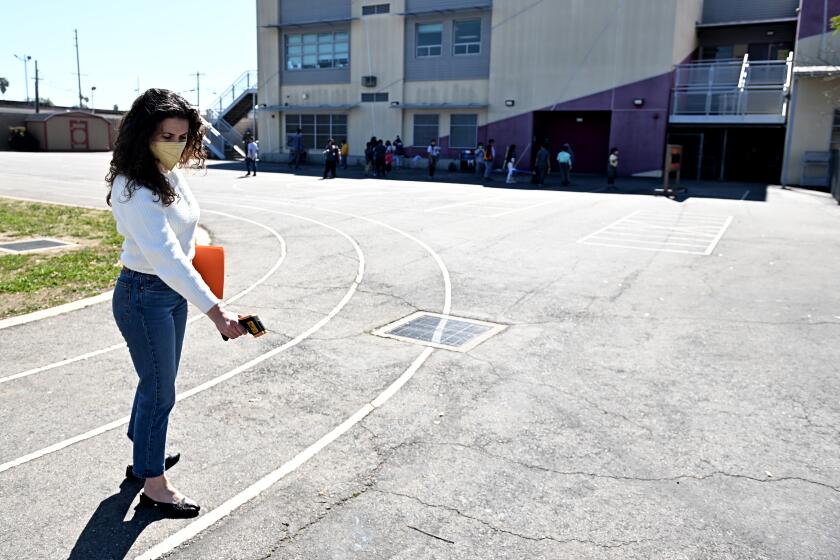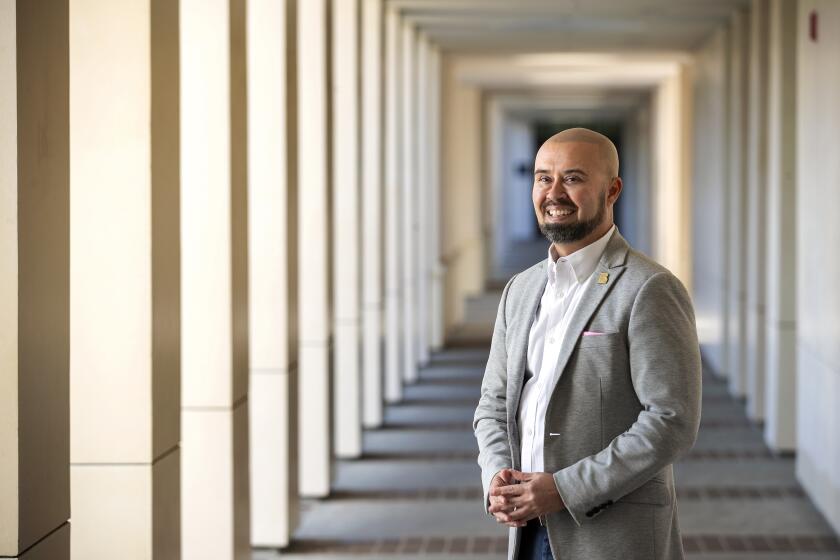D.A. Fitts Was Good Match for Scandalous ‘30s
He was a man who fought crime and his political opponents with the same bare knuckles--and he was tough, surviving three gunshot wounds, more than 20 operations, a grand jury indictment and trial for bribery, and the scandalous revelations in a prostitute’s little black book.
The 1930s were a tumultuous period in Los Angeles County, and Dist. Atty. Buron Fitts won convictions of some of its most notorious figures: Alexander Pantages for rape, Rattlesnake James for murder. He secured guilty verdicts against attorney Morris Lavine for extortion and against his predecessor and mentor, Asa Keyes, for corruption. Fitts forced Tony Cornero, a sleek gambling ship owner, out of L.A. waters.
His penchant for celebrity friends often caused quite a stir, as when he sent his handsomest deputy to Union Station with orders to give the arriving Mae West a big kiss, saying, “This is from Buron.” Her reply has entered legend: “Is that a gun in your pocket, or are you just glad to see me?”
Throughout his three-term career, Fitts raised the rate of successful prosecutions from 55% when he took office to 82% 12 years later. He also gained fame for the speed with which his office disposed of cases. In one instance, three men who admitted to the ransom-kidnapping of William F. Gettle were on their way to San Quentin to serve life sentences just 48 hours after their victim was released.
Despite a bribery and perjury scandal and allegations that he had tampered with murder investigations involving Hollywood stars, his career blossomed.
A native of Texas, Fitts arrived in L.A. with his parents at age 10 in 1905, graduated from Manual Arts High School, and worked his way through USC Law School as a clerk for famed defense attorney Earl Rogers.
A year after he was admitted to the state bar in 1916, he enlisted in the Army during World War I. Though he returned a hero, he suffered a serious knee wound whose lingering effects would, over the years, require him to undergo more than 20 operations.
After serving six years in the district attorney’s office, he took a leave and successfully ran for lieutenant governor in 1926. Two years later, when his former boss, Asa Keyes, was indicted for bribery in the Julian Petroleum swindle, Fitts was elected in his place. Old loyalties did not prevent him from quickly winning a conviction of Keyes.
*
In 1929, as he sat on the opposite side of the courtroom from attorney Jerry “Get Me” Giesler, who was defending theater magnate Alexander Pantages against statutory rape charges, Fitts could not have imagined that he, too, soon would retain the famed defense lawyer.
Fitts’ troubles began in 1930 while he was unsuccessfully seeking the Republican nomination for governor. One of the prosecutor’s own investigators, who was probing the city’s then-flourishing trade in child prostitutes, stumbled across the diary of an L.A. madam. The investigator, Leslie T. White, tracked down the diary’s owner, Olive Clark Day, in a cheap 6th Street hotel. She quickly confessed to supplying wealthy businessmen throughout the Southland with underage girls, and denounced as her accomplice her boyfriend, William Harmon Jobelson, a former employee of Pantages.
She admitted having a contract with wealthy real estate developer John P. Mills, to whom she claimed she delivered a young virgin each week. Hard-pressed to meet their clients’ demands, Day and Jobelson resorted to kidnapping girls from orphanages. Two other names that surfaced in what would become known as the “Love Mart” case were Jesse Shreve and Pantages.
White soon located several of the young prostitutes and convinced them to press charges.
Convicted but out on bail pending his appeal, Pantages and the other two millionaires were taken to San Diego for trial on additional charges. According to testimony there, Mills and Shreve lured Pantages into a business deal by inviting him to a party where they supplied him with young girls.
After a San Diego jury acquitted Pantages and Shreve, Fitts dropped the statutory rape charge filed against Mills by 16-year-old Clarice Tauber. The prosecutor said there was insufficient evidence and that Tauber, the chief witness, had disappeared.
But that didn’t stop Fitts from going after Day. She was eventually convicted, and when Pantages’ conviction was overturned on appeal, became the only figure in the entire scandal to go to prison.
*
Seeking votes from Mexican Americans for his reelection in 1932, Fitts bought political ads on folk singer Pedro Gonzalez’s wildly popular radio program. At the same time, the district attorney stoked rising anti-Mexican sentiments among the county’s white voters. Enraged, Gonzalez publicly opposed Fitts, who nonetheless won. A year later, the prosecutor had Gonzalez indicted on a trumped-up rape charge for which Gonzalez would spend six years in prison.
In 1934, Fitts and his sister, who worked as his secretary, were indicted on charges that they had accepted a bribe to drop the Mills case and then perjured themselves to cover up the transaction.
The indictment alleged that Fitts and his sister had sold a worthless, seven-acre Claremont orange grove their family owned to a Mills employee for $18,500.
Fitts denounced the charges as politically motivated fabrications by a group of “reformers,” including Superior Court Judge Fletcher Bowron. Flanked by his attorneys Joseph Scott, Jack Gilchrist and Giesler, Fitts was tried and acquitted two years later. The charges against his sister were dropped.
However, two years later, Fitts’ body and reputation both were wounded when an unidentified assailant shot him in the arm outside his Duarte home.
Los Angeles was by then in the grip of a reform movement and the determined Fitts managed to hold onto office for two years after the 1938 removal of his mayoral ally, the legendary, corrupt Frank Shaw. Finally, Fitts was defeated at the polls by “good government” reformer John Dockweiler.
After leaving office in 1940, Fitts briefly practiced law with Gilchrist until the U.S. entered World War II and he joined the Army Air Corps. After being wounded and awarded a second Purple Heart, Fitts was discharged and returned to law.
In 1973, distraught and in poor health, the 78-year-old Fitts committed suicide. Even then, there was a celebrity connection: The gun he put to his head was identical to the one used in the unsolved murder of director William Desmond Taylor in 1922. His death was the most notorious case Fitts investigated before becoming D.A.
More to Read
Start your day right
Sign up for Essential California for news, features and recommendations from the L.A. Times and beyond in your inbox six days a week.
You may occasionally receive promotional content from the Los Angeles Times.






